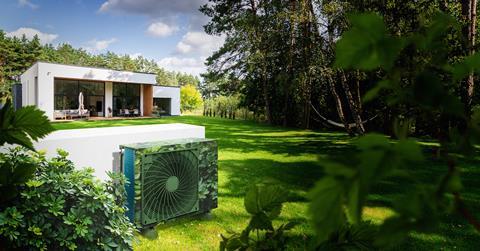VRV specialist at Daikin explains how compact mini-VRV systems can help make it simple to incorporate climate control into a building’s design

Climate control has become an increasingly important part of many developments, especially in urban areas, but integrating these systems into a building can present challenges. Matteo Dall’Ombra, VRV specialist at Daikin explains how compact mini-VRV systems can help make this process simpler.
There are now more factors than ever that must be considered in the design and construction of buildings, especially in dense urban environments. In addition to the architectural requirements, this includes ensuring occupant wellbeing and comfort, compliance with planning regulations and the impact on surrounding buildings. Alongside this is energy efficiency, which is among the factors driving the biggest changes in building design. Due to the need for greater air-tightness, often the only way to achieve good indoor air quality is by utilising the right climate control system.
On residential and smaller commercial urban developments, such as offices and boutique hotels, space is often at a premium meaning finding a suitable location for building a system plant can be a challenge. For these types of developments, compact ‘mini-VRV’ systems, such as the Daikin VRV 5 S-series can provide the solution.

These low-profile, single-fan outdoor units have a height of just 869 mm and a width of 1100 mm. These compact dimensions allow the units to be installed in a wider range of locations, including beneath windows or concealed on balconies. Furthermore, if required the VRV 5 unit can be installed behind grilles or louvres, or in a plant room with ducting to the exterior due to its excellent external static pressure (ESP) of up to 45 Pascals (Pa).
Selecting a compact, low-profile solution can also help to solve line-of-sight issues that may form part of the planning requirements. At less than a metre high, the outdoor units can be easily located behind low walls and roof parapets to hide the system from view. In addition, the typical colours of outdoor units mean that they will stand out when placed against many common building finishes. Therefore, to reduce the visual impact, it may be necessary to find a way to blend the unit into its surroundings.
As an example, at Daikin we provide a wrapping service to create bespoke patterned vinyl wraps for our outdoor units. Using a high-resolution photo of the background where the unit will be installed, we create a matching vinyl to conceal the unit. As an alternative approach to disguising the unit, we can also supply it painted in a specified colour or pattern.

Another area that must be considered when selecting and planning a climate control system is the sound impact and the related regulations. For example, the City of London planning regulations states that “The level of noise emitted from any new plant shall be lower than the existing background level by at least 10 dBA” and that “Noise levels shall be determined at one metre from the window of the nearest noise sensitive premises”. As a result, if the level of sound produced is too high there will be limitations on where the outdoor units can be installed.
The first step is to ensure that the specified unit has been engineered for quiet operation. The Daikin VRV 5 S-series has features such as a redesigned, asymmetric fan that helps keep operational sound levels low. It also includes a low-noise mode that further reduces the sound. This function, sometimes referred to as ‘night operation mode’, reduces the noise by limiting the maximum fan and compressor speed.
This does reduce the power of the unit slightly and so it is often used at night, when demand is lower, to minimise disturbance where the unit is close to a window of the building itself or that of a neighbouring property. Where this mode will be used, it is important to work with the manufacturer on the selection of the unit to ensure the required heating and cooling performance is achieved.

Furthermore, the sound levels can be reduced by equipping the unit with a sound-insulating enclosure. Choosing an acoustic solution supplied by the manufacturer of the climate control system is often simpler and more cost-effective when compared to third-party options. The sound enclosure available for the VRV 5 S-series units, which has been fully optimised and tested in the Daikin factory, provides up to a 9 dBA reduction in sound while still ensuring performance levels are maintained. It has also been designed to ensure easy access for maintenance and is fully weather-resistant.
Although overcoming challenges such as the correct placement of the unit or sound levels is essential, the environmental impact of any building system will always remain a priority. The VRV 5 S-series units have been engineered for efficiency and sustainability. It features Daikin’s Variable Refrigerant Temperature (VRT) technology, which adjusts the amount of refrigerant flowing through the system and alters the evaporating and condensing temperatures to match demand, meaning significantly less energy is required.
The VRV 5 S-series has also been designed around the R-32 refrigerant. This has a significantly lower global warming potential (GWP) compared to previous generation refrigerants and is also more energy efficient, allowing a lower total system charge. R-32 is also easy to reclaim and recycle as it is a single component refrigerant.
The integration of climate control systems into a building can be especially challenging in urban settings where planning requirements and other considerations restrict where the outdoor units can be placed. Mini-VRV systems, such as the Daikin VRV 5 S-series, provides a possible answer to these issues and working closely with manufacturers can help ensure the optimum solution is designed.
To find out more about Daikin’s range of VRV climate control systems visit: www.daikin.co.uk.















![Ashton Sixth Form College - EQUITONE [tectiva]](https://d3rcx32iafnn0o.cloudfront.net/Pictures/100x67/3/6/4/1996364_ashtonsixthformcollegeequitonetectiva_882316.jpg)